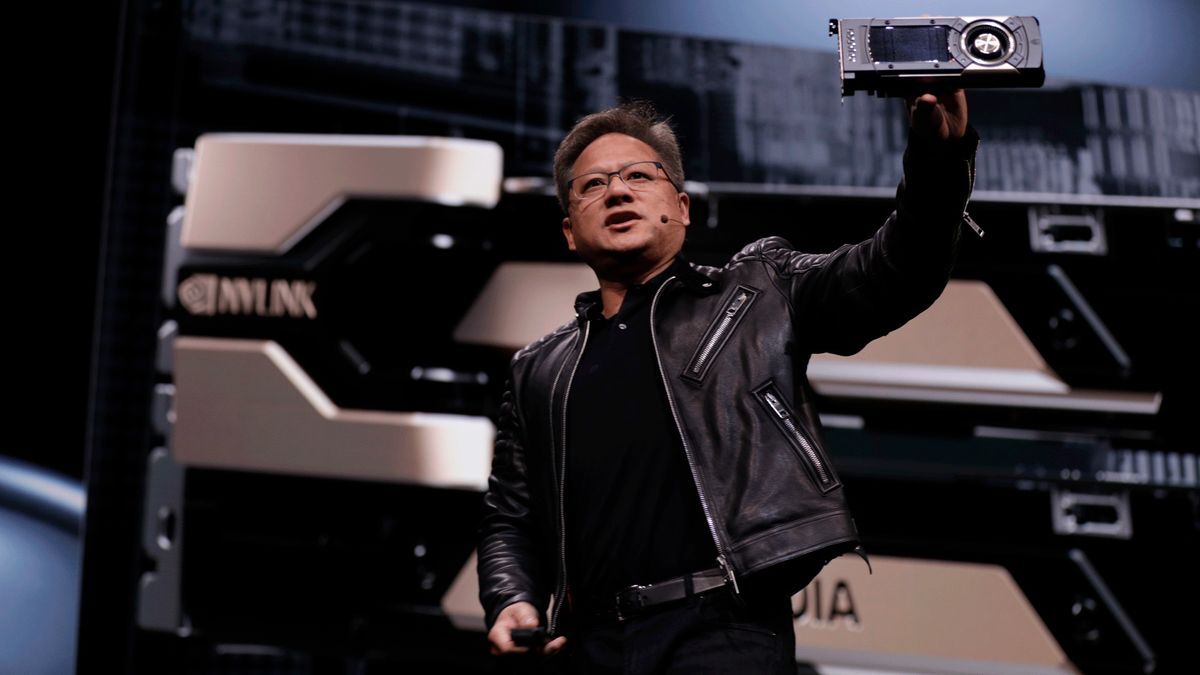Lol. Lmao.
In the funniest timeline, the US nationalizes Nvidia to delay China from making chips that work well with LLM’s… by a year tops.
Link to original Fortune article the PC Gamer article pulled from, with this juicy relevant quote:
To do that, Raimondo said the Commerce Department’s Bureau of Industry and Security, which manages export controls for the US, needs more funding from Congress.
“I have a $200 million budget. That’s like the cost of a few fighter jets. Come on,” she said. “If we’re serious, let’s go fund this operation like it needs to be funded.”



Soon enough is not going to be as fast as you think. The issue is TSMC has a complete equipment and knowledge monopoly and we are not talking about a 5 or 10 year lead. We are talking more 15 to 20 on anyone that just wants to catch up at this stage.
I’m not sure that’s true anymore. China has done pretty well at poaching TSMC engineers, and the US embargo has essentially forced China to eat it’s own dog food and hothouse development. They’ve already regained capability far faster than the US anticipated. TSMC only has an institutional and hardware monopoly at this point I’d guess, Knowledge has already diffused into Mainland China.
Yeah. It’s actually Russia that is around 10 to 15 years from catching up. I’ve been following both the Russian and Chinese state firms in charge of developing semiconductor fab tooling. The main Chinese firm is about to make a full two or three generation leap past ASML (the top western firm) in the coming 3 or so years. The Russian state firm in charge of this type of tooling hasn’t made anything since shortly before the USSR fell, back when Russia still maintained semiconductor lithography tech parity with the US and only right around the time the Ukraine war kicked off have they started back up their r&d.
The new EUV light source and lithography machines China has going into trial production are more advanced than anything ASML (where TSMC & western fabs get their EUV light source) has in the works. China decided to leapfrog the western firms by skipping the inefficient method of vaporizing tin microspheres with a laser to make pulses of EUV light (extremely inefficient, low quality light) and instead is going with particle accelerators to generate continuous EUV light that is higher quality (greater culmination, narrower frequency range) and higher output (10 to 100 times brighter for given power input) while using less valuable fab infrastructure space. Because a particle accelerator lacks all the moving parts and is mostly solid state, it has many times greater mean time between failure compared to the ASML machines that have duty cycles around only 90% operational uptime and 10% maintenance downtime. Rather than needing to build/buy a dozen or more EUV machines to equip a fab at scale (one ASML light source per lithography station) and have them still be a production bottleneck, you can install a single one of the Chinese particle accelerator light sources to provide EUV light to more than a dozen lithography stations placed around the circumference of its ring.
edit:
another observation. the western lithography tooling firms seem to be at a tech development disadvantage because they make so much of their money from service contracts to maintain the machines they sell. I could never see ASML decide on their own to create the type of hardware Chinese state firms have in the works because the complexity and unreliably of their machines is a major source of revenue after they make the initial sale. Their board of directors and shareholders would never allow it. ASML would also never design a machine that can replace a dozen or more machines of the same cost even if it meant higher quality output for the end user. This is why I can’t see them competing in the long run now that China has made development of advanced lithography tooling a national priority with full backing of the state.
Hey, nice to see someone with some industry knowledge posting! I would extrapolate the “service contract” model’s inefficiency to the whole industry. It’s not just lithography, it’s also everyone from etch and defect metrology, to testing/binning and packaging. The big semiconductor names don’t build any of the production tools. TSMC, Intel, Samsung, and the other fab owners buy all of their tools from other companies, and those other companies sell them service contracts in order to more effectively hoard their IP.
A state-owned enterprise that does all of its own service and R&D would blow the capitalist firms out of the water. I estimate that 80% of the workforce at any given fab is superfluous, and only employed to safeguard each company’s IP. All of this increases production downtime, as the manufacturing technicians aren’t allowed to know enough to fix problems themselves and have to wait on the service company’s service engineers to show up to do anything more than the most basic tasks. On top of the actual manufacturing inefficiencies this model introduces, the capitalists from each company involved are taking their outsized takes from every transaction. Some of it goes to funding R&D, but a state owned enterprise would be able to redirect significantly more profits to R&D.
GOOD post
Aside from path dependency/capitalism is there a reason no firm in the west has jumped on this new tech?
It’s mostly path dependency. Semiconductor fabs are hideously expensive, you don’t want to build a new one from scratch every generation, and this tech is new. China having not invested in extensive lithography machine manufacture before now means they can jump straight to the best tech.
That makes sense. Thanks!
Googled a bit but I have no idea how they’re generating EUV from a particle accelerator. It supposedly “captures the energy emitted by high-energy particles during acceleration”, but again, I have no idea how that would work. Are they just phrasing “and then it was slammed into a target” in a weird way?
Here are a few papers on the subject in chronological order:
Extreme ultraviolet (EUV) sources for lithography based on synchrotron radiation (2001) - https://www.sciencedirect.com/science/article/abs/pii/S0168900201008877
Steady-State Microbunching in a Storage Ring for Generating Coherent Radiation (2010) - https://journals.aps.org/prl/abstract/10.1103/PhysRevLett.105.154801
Demonstration of a ring-FEL as an EUV lithography tool (2020) - https://journals.iucr.org/s/issues/2020/04/00/ve5121/index.html
Experimental demonstration of the mechanism of steady-state microbunching (2021) - https://www.nature.com/articles/s41586-021-03203-0
A synchrotron-based kilowatt-level radiation source for EUV lithography (2022) - https://www.nature.com/articles/s41598-022-07323-z
Thank you, will give these a read later!
China is currently producing 7nm and will have 5nm by the end of next year. China reaching 3nm is more likely within 5 years, then the final catchup will be 2nm. 5-10 years is the maximum.
how do i apply to do this corporate espionage for the CCP
deleted by creator
I kinda doubt this is true. Gamers Nexus did a very interesting video recently ish about a Chinese made video card and it wasn’t as bad as you would expect. It had a lot of driver issues but as a graphics card it was more on par with a 10 year old card. This is for rasterization of course not AI but the company in question hasn’t been making cards for long, just a couple of years, and it is making headway fast. With the correct funding and interest I don’t see any reason why China can’t at least catch up to TSMC. Their processes are broadly understood, enough scientists with enough funding can figure it out.
Yeah. Moorethreads is the company iirc. To put things in perspective, Intel recently also got serious about competing with Nvidia and AMD on discrete GPUs. Intel already has decades of experience making integrated GPUs and has had multiple failed starts into the discrete GPU market but Moorethreads who started a couple years later than Intel’s most recent push, is at about the same stage of development as them.
Like Intel, they are a lot closer to Nvidia/AMD on hardware (roughly 4 - 5 years) than benchmarks make it seem but are being held back by just how much work it takes to bring the software driver stack up to the same level as Nvidia/AMD. Both Intel and Moorethreads are around 10 to 15 years behind Nvidia/AMD on driver software but this is a little misleading because both companies have decided to mostly abandon older graphics/compute apis (DirectX 9/10/11, OpenGL) to focus all their software development work on DirectX12/Vulkan. DirectX12 and Vulkan both have extensions that can handle software written for the older APIs at a 10 - 20% performance hit, which is a fair trade since newer software is more often than not DX12/Vulkan native.
With newer APIs like DX12 and Vulkan, less optimization happens at the graphics API/driver level with instead developers being given low level access to make the optimizations themselves. So, if they can get enough of these new GPUs into the hands of end users, developers will be forced to optimize games and applications for them. This is why both Intel and Moorethreads are just going into full scale mass production and selling their cards almost at-cost.
Intel is controlled by their US defense liaisons, accounting departments, and marketing departments. They will struggle where a company controlled by the manufacturing and design people succeed.
TSMC doesn’t make their manufacturing tools. They buy all of their production tools from other companies (ASM, KLA, Hitachi, Applied Materials, Tokyo Electron, etc), they only create the facilities and chip designs. It’s the same structure throughout the whole semiconductor industry.
They don’t create the chip designs, they create the manufacturing processes, which aren’t as difficult to catch up to as people think.
I work in manufacturing. If there’s is a will, there’s a way.
deleted by creator
Even TSMC’s own attempts to set up a fabrication plant in the USA is struggling horribly to find enough capable staff.
I don’t think TSMC is 20 years ahead of everyone else, but ASML’s EUV photolithography machines probably are, and those are under embargo to China too.